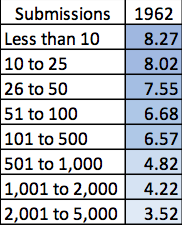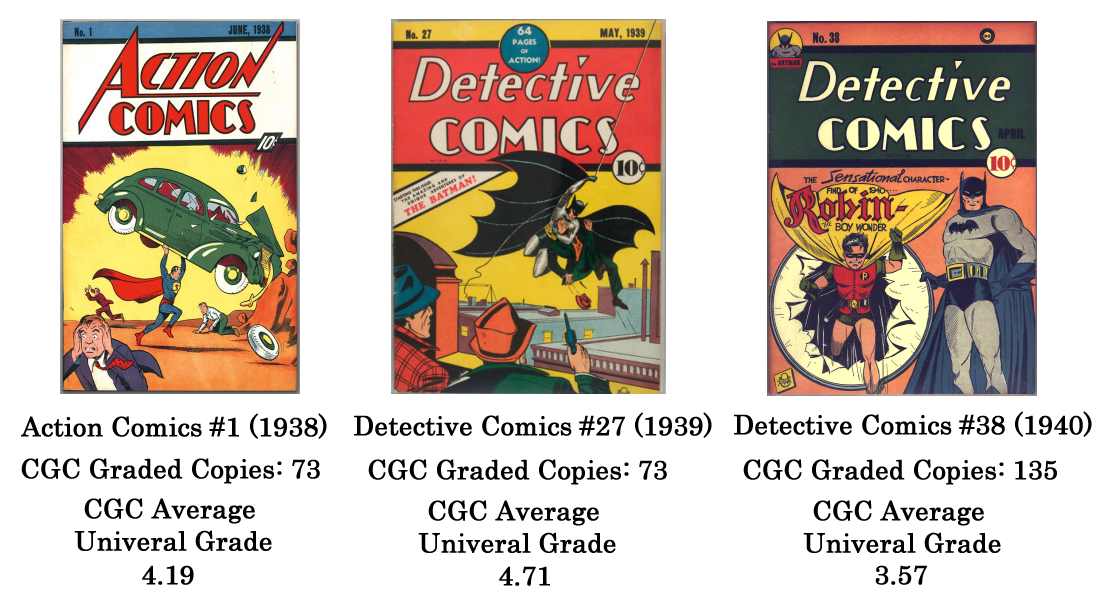CGC Average Grades - More Than Meets The Eye?
In the very first article written for GPAnalysis.com (GPA) exploring CGC Census information and GPA data (https://comics.gpanalysis.com/news/2020/how-far-do-cgc-average-grades-drop-as-comics-get-older) nearly a year ago, average universal grades on the CGC Census were calculated and reported. The CGC Census does not represent a random sample of all comic books in existence but a reflection of what has been deemed to be in “CGC worthy” condition.
In addition to condition, people have different factors to determine “CGC worthiness” for a given comic book, which are usually a combination of comic book’s value, age, artwork, story, rarity, history, and more personal factors such as their own memories and favorites. These additional factors influence which conditions are submitted for each book and which books are submitted most often.
AVERAGE UNIVERSAL CGC GRADE
Average universal grades by decade on the CGC Census a year ago were:

Currently, the average universal grades by decade are:

Blue color-shading indicates lower (lighter) or higher (darker) average CGC universal grades. It is clear from these calculations that the average universal graded on the CGC Census generally decreases as the age of the comic book increases. This matches conventional thinking that older comic books may have been less protected and have had more time to deteriorate, accumulate damage, and show defects.
The total universal grades on the CGC Census has increased by almost one million from 4,267,080 in June 2020 to 5,195,544 in June 2021, and very little changed for the average universal grades by decade. There is a small amount of change, however, and it is in the downward direction, where the average grade for all decades declined slightly as the number of submissions has increased and another year has passed.
Two observations for average universal CGC grades:
OBSERVATION 1 = The average universal grade on the CGC Census generally decreases as the age of the comic book increases.
OBSERVATION 2 = The average universal grade on the CGC Census generally decreases as the number of CGC submissions increases.
Further evidence for these two observations can be seen by isolating a single year in the average universal CGC grade analysis. The 1960s show an average universal CGC grade of 7.02, which is higher than older comics and lower than newer comics, confirming the first observation. Within a single year the books would be the same age, so the second observation can be demonstrated by the average universal CGC grade according to how many copies of each book have been graded, such as this calculation for books from 1962.

This decrease in the average grade as submissions increase is understandable because a comic book which is submitted to CGC more often is more likely to be submitted in a wider range of conditions.
The average universal grade on the CGC Census generally (Observation 1) decreases as the age of the comic book increases or (Observation 2) decreases as the number of CGC submissions increases.
Hypothetically, the lowest average grade on the CGC Census should belong to the oldest comic book which has been submitted more often than any other comic. However, there are books on the CGC Census with only one copy graded and the grade is CGC 0.5, the lowest possible CGC grade. The comic book which has been submitted most often is Amazing Spider-Man #300 (1988), with an average universal CGC grade of 8.71, which is not the lowest average compared to comics which are decades older. The hypothetical “perfect” situation doesn’t occur within the CGC Census, but the data that is available may prove more useful than just providing simple observations.
SILLY MATH - 100% OF EXISTING COPIES EXIST
The number of copies still in existence is unknown for almost all comic books and will likely always be unknown for an exact answer, but the exact percentage still in existence is known. It is 100%. There are exactly 100% of all existing copies, whatever that number might be. This is a silly answer - all existing copies are existing - but this fact about the percentage existing may actually be helpful in estimating how many copies exist.
P (percentage of existing copies already CGC graded) = C (CGC census count) / E (copies existing)
P = C / E
The value of C (CGC census count) comes directly from the CGC Census. Both P and E are unknowns, but E isn’t dependent upon the CGC Census counts. While E is an unknown, it is also a constant. The number of copies in existence stays the same regardless of the CGC Census numbers, whether all the copies have been CGC graded or none of them has. P is the unknown variable which does change based upon the CGC Census counts. The value of P is unknown, but P increases as C increases (because E is always 100% of itself). This fact allows any estimated value of P to also estimate the value of E. Adjusting the formula to “solve for E” results in:
E (copies existing) = C (CGC census count) / P (percentage of existing copies already CGC graded)
E = C / P
It has been estimated that around half of all copies of Action Comics #1 (1938) have been CGC graded. In the E = C / P formula, the E (copies existing) for Action Comics #1 would be C (73 copies graded) / P (50% or 0.5). The value of E for Action Comics #1 would be 146 copies estimated to exist if P = 50%. If the estimate for P is widened to 40% to 60%, the estimate for E would be 122 to 183 copies estimated to exist. The exact number of copies existing, E, is unknown, but a reasonable estimate from experts in the hobby would be 122 to 183 copies for P = 40% to 60%.
AVERAGE GRADE COINCIDENCES
The average universal CGC grade for Action Comics #1 is 4.19. The estimate for P is 40% to 60%. Is it a coincidence that 4.19 is 41.9% of the maximum CGC 10 grade and the estimate for P is 40% to 60%? Yes! Any single example of numbers which coincide should be considered a coincidence. “Coincide” is even the basis for the word “coincidence”.
Experts also estimate that around half of all copies of Detective Comics #27 (1939) have been CGC graded. The average universal CGC grade for Detective Comics #27 is 4.71. Once again, the average CGC grade is 47.1% of the maximum CGC grade, and the estimate for P is 40% to 60%. This is still a coincidence, right? Most likely a coincidence, but it does seem worthy of further investigation.
Both Action Comics #1 and Detective Comics #27 currently have 73 copies CGC graded. Only the universal CGC grades are included in the average because restored grades are no longer reflecting the original condition of the comic book. Action Comics #1 is slightly older than Detective Comics #27, and the average universal CGC grade is lower (testing Observation 1), while the number of CGC graded copies is the same (removing Observation 2 from the equation).
Detective Comics #38 (1940) is another key issue from the Golden Age, from the same title and nearly the same age as Detective Comics #27. The average universal CGC grade for Detective Comics #38 is 3.57. This average grade is lower than both Action Comics #1 (1938) and Detective Comics #27 (1939). According to Observation 1 (older is generally a lower average grade), the average universal CGC grade for Detective Comics #38 would not be expected to be lower, but Observation 2 (more submissions is generally a lower average grade) could be a more important factor. In this case, Detective Comics #38 has 135 copies already CGC graded. This number of copies already CGC graded nearly doubles both Action Comics #1 and Detective Comics #27 at 73 copies each and may indicate that a higher percentage of existing copies for Detective Comics #38 have been CGC graded, higher than the 40% to 60% estimated for Action Comics #1 and Detective Comics #27.

If Detective Comics #38 has greater than 40% to 60% of the existing copies already CGC graded, the average universal CGC of 3.57 could also coincide with 35.7% ungraded copies remaining in existence.
That would establish an estimate for Detective Comics #38’s P value as 64.3% already graded (100% minus 35.7% ungraded), which is slightly above the 40% to 60% estimated for Action Comics #1 and Detective Comics #27. Again, this could be just a coincidence, but an estimate for P is beginning to gain evidence from the existing data.
ESTIMATING THE VALUE OF P
There is a possibility that the value of P can be estimated as 100% minus the average universal CGC grade (as a percentage of CGC 10).
A = average universal CGC grade (out of 10)
When the average universal CGC grade is 9.6, the value of A would be 0.96 or 96%. When the average universal CGC grade is 2.5, the value of A would be 0.25 or 25%.
If P = 1 – A, the percentage of existing copies already CGC graded would be estimated from the average universal CGC grade. This is not an estimate based on careful consideration of all of the potential variables that impact why a particular comic book is submitted to CGC, which are usually a combination of comic book’s value, age, artwork, story, rarity, history, and more personal factors such as their own memories and favorites. At this point, P = 1 – A would be an estimate based only on coincidences.
P = 1 – A, THE COINCIDENCES START PILING UP
In addition to the coincidences mentioned for Action Comics #1, Detective Comics #27, and Detective Comics #38 where P = 1 – A for older comic books with low average universal CGC grades, the opposite end of the spectrum would involve cases where newer comic books have higher average universal CGC grades. These three books are examples of coincidences for P = 1 – A where both Observation 1 (age of the comic) and Observation 2 (number of submissions) have an impact.
If P = 1 – A for older comics with a higher percentage of books already CGC graded, then consider the opposite, a newer comic book with an average universal CGC grade of 9.8. In this scenario, it is unlikely that a high percentage of existing copies have already been CGC graded, unless the entire supply is somehow protected from damages with an indestructible cover, or perhaps all existing copies were submitted to CGC directly from the printer and encapsulated immediately after printing.
When the average universal CGC grade is 9.8, the formula P = 1 – A would estimate that only 2% of the existing copies have been CGC graded. This estimate for P would increase to 6% of the existing copies already CGC graded when the average universal CGC grade is 9.4. For a comic book with an average universal CGC grade of 9.0, the estimate for P would be 10% of existing copies already CGC graded. Are these reasonable estimates? The answer is likely to be “sometimes”. If it’s only true sometimes, then it’s likely to be another coincidence.
Returning to Observations 1 and 2, a newer comic book with a high average universal CGC grade and a low number of CGC submissions would be the opposite of the two observations identified in this article, and it is reasonable to assume that these newer, high average grade, low submission books would be the least likely to prove any points built upon the estimate for P = 1 – A.
P = 1 – A is unlikely to be a good estimate when comic books are newer with a low percentage of CGC submissions.
P = 1 – A is possibly a good estimate when comic books are older with a higher percentage of CGC submissions.
What about the books in between? Moderately older books submitted to CGC a moderate number of times. In a future article in this series, P = 1 – A will be applied to a much wider variety of comic books, to determine if the coincidences continue to happen or if the whole concept is too far from reality to be useful. By the time this series of articles is over, we may have a comic book world equivalent for the formula that E = MC-squared, or we may have nothing at all.
About the Author
 |
Greg Holland has collected comic books for over 30 years and has been the administrator of the CGC Census Analysis website since 2003, currently located at CGCdata.com. He is the 1999 founder of the ValiantComics.com website and the 2004 ValiantFans.com message board. Dr. Holland holds a Ph.D. in information quality from the University of Arkansas at Little Rock and has held data science positions as research director, analyst, and administrator for government, corporations, and university. Active on the CGC Forums as ‘valiantman’ since 2002, he is also a 15+ year advisor to the Overstreet Comic Book Price Guide and contributor to later editions of the Standard Catalog of Comic Books. Greg resides in Arkansas, USA, with his wife and their daughter. |
Related news
24 Oct 2022
Canadian Price Variants (CPVs) and GPAnalysis.com Recorded Sales
With Canadian Price Variants recorded in GPAnalysis.com for decades, what can the data tell us about rarity and value when comparing against direct editions?
Read more26 May 2022
CGC Census - A Game for the Thousandth Collector
Imagine a game where 1,000 lucky comic collectors are awarded the best available copies of comic books from the CGC Census. Where would ticket #1,000 be for the earliest appearances of favorite characters? Some winning books may surprise you.
Read more